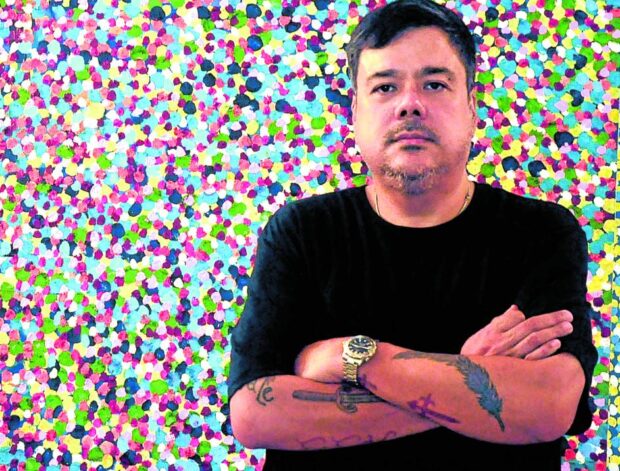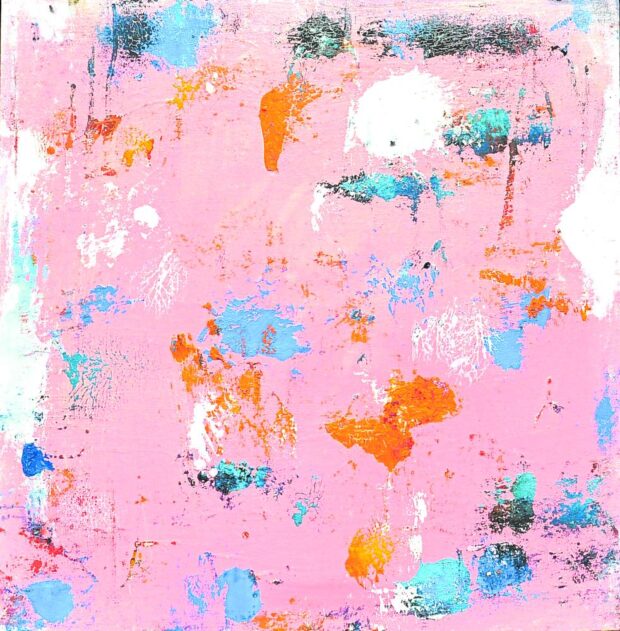The first painting Dranreb Belleza sold was to his godfather Fernando Poe Jr. (FPJ).
After Dranreb’s debut art exhibit at Music Museum back in 1994, the late National Artist for Film took a fancy to one of the pieces on display, “a blue abstraction,” and offered to buy it.
“But why?” the former child star said. After all, it was FPJ who helped further Dranreb’s education in the arts. After his stay at the University of the Philippines (UP) College of Fine Arts in the late 1980s, Dranreb was sent by FPJ to the United States to take up visual communications at Santa Monica College in California.
![Dranreb Belleza with Fernando Poe Jr. [from Edgar Cruz Facebook]](https://entertainment.inquirer.net/files/2023/08/514047-620x620.jpeg)
Dranreb Belleza with Fernando Poe Jr. [from Edgar Cruz Facebook]
“I told him, ‘Why do you want to pay for it? You sent me to school!’ And he said, ‘Wala… para swerte,’” Dranreb told the Inquirer in a recent video conference for his ongoing solo art exhibit, “It’s All Connected,” which runs until Aug. 12 at Art Circle Gallery in UP Diliman’s Ang Bahay ng Alumni.
“He told me to give him a price. I thought he was just teasing me into asking for a big amount, so that he could turn it down later on. I asked for P7,000, which, at the time, was already a lot of money. And he just said, ‘Alright, go get your check at the house tomorrow,’” Dranreb, or simply Reb on the art scene, said.
Influence
Much to Dranreb’s surprise, FPJ cleared a nook full of paintings in his home to give way for the new addition to his art collection—a touching gesture the then budding painter would never forget.
“I was very close to my ninong. He had a lot to do with my morals and who I am right now. My integrity and principles… they came from him,” said Dranreb, whose mother is 1960s star Divina Valencia, who topbilled the 1967 movie “Mga Alabok sa Lupa” with FPJ.
But before “Da King” supported his career, it was “The Queen,” Susan Roces, who first took notice of his artistic inclinations.
On the set of the 1974 film “Dalawa ang Nagdalantao sa Akin,” the young Dranreb would rather play than rest during breaks. And so, Susan thought of giving Dranreb coloring books and crayons.
“I was around 4 years old back then. The movie also starred Boots Anson-Roa and Ronaldo Valdez. I loved drawing and coloring from a very young age. My Ninang Susan gave me big coloring books and crayons,” related Dranreb, who has appeared in films like Eddie Romero’s “Ganito Kami Noon… Paano Kayo Ngayon” (1976), and shared the screen with FPJ in “Pagbabalik ng Lawin” (1975) and Gerardo de Leon’s unfinished masterpiece “Juan dela Cruz” (1976).
‘Nepo baby’
Aside from FPJ and Susan, Dranreb also had the late “King of Comedy” Dolphy, movie queen Amalia Fuentes and writer-director Emmanuel Borlaza as godparents. Having all these greats around him growing up, supporting him and treating him like their own, Dranreb admitted that he had a very charmed life.
He was a “nepo baby” by his own admission. The kind of family and world he was born into was beyond his control. But what he could do was prove that he deserved the opportunities that came his way.
“My godparents and parents opened doors for me, but I worked hard to pay my dues. I shed blood, sweat and tears. I was consistent with my work. You won’t last in the art world if you don’t have the talent,” he said. “I studied. ’Di naman ako nag-trip lang na magpintura o bolahin ang mga tao.”
“I can’t have a mediocre show in UP, for instance,” he stressed. “I know I have to produce something worthy to be housed in the hallowed grounds of my beloved university… the university that trained me.”
Dranreb has participated in more than 30 art shows, including the prestigious Venice Biennale in Italy in 1999 and Installations Along Cameron Road in Hong Kong in 2019. His work has been displayed in various art centers, galleries, cafés and hubs, like Pinto Art Gallery, J Studio and Archivo 1984.
He’s a regular presence in the UP College of Fine Arts Alumni Association’s exhibits. He also worked as an art lecturer at St. Paul University Manila and La Salle Green Hills.
“That’s something they can’t take away. I still had to contend with the gatekeepers of the art world who didn’t think I was worthy to be here. There were a lot of rejections. There were raised eyebrows among my peers. A lot of doors opened for me, but I had to work my ass off to be at Pinto or J Studio, and be among people I’m a fan of.”
“I wanted to be known, not for who I knew, but for my portfolio. I worked hard… and I still do,” he said. INQ



